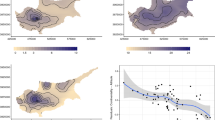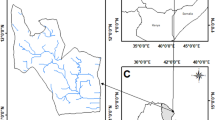Abstract
This study uses Bayesian networks (BNs) to simulate the spatial distribution of southern African biomes and bioregions using bioclimatic variables. Two Tree-Augmented Naïve (TAN) BN models were parameterized from 23 bioclimatic variables using the expectation-maximization (EM) algorithm. Using sensitivity analyses, the relative influence of each variable was determined using the mutual information from which six bioclimatic variables were selected for the final models. Precipitation of the warmest quarter and extra-terrestrial solar radiation was found to be the most influential variables on both bioregion and biome distributions. Isothermality was the least influential bioclimatic variable at both bioregion and biome levels. Overall correspondence was very high at 93.8 and 87.1% for biomes and bioregions, respectively, whereas classification errors were obtained in transition areas indicating the uncertainties associated with vegetation mapping around margins. The findings indicate that southern African bioregions and biomes can be classified and mapped according to key bioclimatic variables. Spatio-temporal, in particular, monthly and quarterly variations in both precipitation and temperature are found to be ecologically significant in determining the spatial distribution of biomes and bioregions. The findings also reflect the hierarchical relationship of biomes and bioregions as a function of local bioclimatic gradients and interactions. The results indicate the ecological significance of bioclimatic conditions in ecosystem science and offer the opportunity to utilize the models for predicting future responses and sensitivities to climatic changes.






Similar content being viewed by others
References
Acocks JPH. 1953. Veld types of South Africa. Mem Bot Survey S Afr 28:1–192.
Ames DP, Anselmo A. 2008. Bayesian network integration with GIS. In: Shekhar S, Xiong H, Eds. Encyclopedia of GIS. New York: Springer. p 39–45.
Archibald S, Roy DP, Van Wilgen BW, Scholes RJ. 2009. What limits fire? An examination of the drivers of burnt area in southern Africa. Glob Change Biol 15:613–30.
Ascough JCII, Maier HR, Ravalico JK, Strudley MW. 2008. Future research challenges for incorporation of uncertainty in environmental and ecological decision-making. Ecol Model 219:383–99.
Barco R, Lázaro P, Díez L, Wille V. 2005. Multiple intervals versus smoothing of boundaries in the discretization of performance indicators used for diagnosis in cellular networks. In: Gervasi O, Ed. Computational science and its applications-ICCSA 2005. Berlin, Heidelberg: Springer. p 958–67.
Bonan G. 2002. Ecological climatology—concepts and applications. Cambridge: Cambridge University Press.
Bond WJ, Midgley GF, Woodward FI. 2003. What controls South African vegetation–climate or fire? S Afr J Bot 69:79–91.
Borsuk ME, Stow CA, Reckhow KH. 2004. A Bayesian network of eutrophication models for synthesis, prediction and uncertainty analysis. Ecol Model 173:219–39.
Box EO. 1981. Macroclimate and plant forms: an introduction to predictive modeling in phytogeography. The Hague: Dr W Junk Publishers.
Box EO, Fujiwara K. 2005. Vegetation types and their broad-scale distribution. In: van der Maarel E, Ed. Vegetation ecology. Oxford: Blackwell Publishing. p 106–28.
Churkina G, Running SW. 1998. Contrasting Climatic Controls on the Estimated Productivity of Global Terrestrial Biomes. Ecosystems 1:206–15.
Clark JS, Gelfand AE. 2006. A future for models and data in environmental science. Trends Ecol Evol 21:375–80.
Congalton RG, Green K. 2009. Assessing the accuracy of remotely sensed data: principles and practices. 2nd edn. Boca Raton: CRC Press.
Cowling RM, Hilton-Taylor C. 1999. Plant biogeography, endemism and diversity. In: Dean WRJ, Milton SJ, Eds. The Karoo: ecological patterns and processes. Cambridge: Cambridge University Press.
Cowling RM, Esler KJ, Midgley GF, Honig MA. 1994. Plant functional diversity, species diversity and climate in arid and semi-arid southern Africa. J Arid Environ 27:141–58.
Cramer W. 2002. Biome models. In: Mooney HA, Canadell JG, Eds. Encyclopedia of global environmental change, Volume 2. The earth system: biological and ecological dimensions of global environmental change. Chichester: Wiley. p 166–71.
Ellery WN, Scholes RJ, Mentis MT. 1991. An initial approach to predicting the sensitivity of the South African grassland biome to climate change. S Afr J Sci 87:499–503.
Environmental Systems Research Institute. 2008. ArcGIS, version 9.3. Redlands (CA): Environmental Systems Research Institute.
Friedman N, Geiger D, Goldszmidt M. 1997. Bayesian network classifiers. Mach Learn 29:131–63.
Green JL, Hastings A, Arzberger P, Ayala FJ, Cottingham KL, Cuddington K, Davis F, Dunne JA, Fortin MJ, Gerber L, Neubert M. 2005. Complexity in ecology and conservation: mathematical, statistical and computational challenges. Bioscience 55:505–10.
Guyon I, Elisseeff A. 2003. An introduction to variable and feature selection. J Mach Learn Res 3:1157–82.
Hijmans RJ, Cameron SE, Parra JL, Jones PG, Jarvis A. 2005. Very high resolution interpolated global terrestrial climate surfaces. Int J Climatol 25:1965–78.
Holdridge LR. 1947. Determination of world plant formations from simple climatic data. Science 105:367–9.
Huang J, Yuan Y. 2007. Construction and application of Bayesian network model for spatial data mining. In: Proceedings of IEEE international conference on control and automation, Guangzhou, China, May 30 to June 1, 2007. pp 2802–5.
Irish J. 1994. The biomes of Namibia, as determined by objective categorization. Navors Nas Mus 10:549–92.
Köppen W. 1936. Das geographische system der klimate. Köppen W, Geiger R, Eds. Berlin: Handbuch der Klimatologie, Gebrüder Borntraeger. pp 1–50.
Laskey KB. 1995. Sensitivity analysis for probability assessments in Bayesian networks. IEEE Tran Syst Man Cybernet 25:901–9.
Lauritzen SL. 1995. The EM algorithm for graphical association models with missing data. Comput Stat Data Anal 19:191–201.
Low AB, Rebelo A. 1998. Vegetation of South Africa, Lesotho and Swaziland. Pretoria: Department of Environmental Affairs and Tourism.
Mucina L, Rutherford MC. 2006. The vegetation of South Africa, Lesotho and Swaziland. Strelitzia 19. Pretoria: South African National Biodiversity Institute.
Norsys Software Corp. 2010. Netica, version 4.16. Vancouver (BC): Norsys Software Corporation.
Okitsu S. 2010. Vegetation structure of the biomes in southwestern Africa and their precipitation patterns. Afr Study Monogr 40:77–89.
Pearl J. 1988. Probabilistic reasoning in intelligent systems: networks of plausible inference. San Mateo: Morgan Kaufmann.
Peng H, Long F, Ding C. 2005. Feature selection based on mutual information: criteria of max-dependency, max-relevance, and min-redundancy. IEEE Trans Pattern Anal Mach Intell 27:1226–38.
Pole Evans IB. 1936. A vegetation map of South Africa. Mem Bot Surv S Afr 15:1–23.
Pollino CA, Woodberry O, Nicholson AE, Korb KB, Hart BT. 2007. Parameterisation and evaluation of a Bayesian network for use in an ecological risk assessment. Environ Model Softw 22:1140–52.
Prentice IC, Cramer W, Harrison SP, Leemans R, Monserud RA, Solomon AM. 1992. A global biome model based on plant physiology and dominance, soil properties and climate. J Biogeogr 19:117–34.
Rutherford MC. 1997. Categorization of biomes. In: Cowling RM, Richardson DM, Pierce SM, Eds. Vegetation of Southern Africa. Cambridge: Cambridge University Press. p 91–9.
Rutherford MC, Westfall R. 1994. Biomes of southern Africa—an objective categorization. Mem Bot Survey S Afr 63:1–94.
Rutherford MC, Mucina L. 2006. Introduction. In: Mucina L, Rutherford MC, Eds. The vegetation of South Africa, Lesotho and Swaziland. Cape Town: Strelitzia. p 3–11.
Rutherford MC, Mucina L, Powrie LW. 2006. Biomes and bioregions of Southern Africa. In: Mucina L, Rutherford MC, Eds. The vegetation of South Africa, Lesotho and Swaziland. Cape Town: Strelitzia. p 32–50.
Rutherford MC, Mucina L, Powrie LW. 2008. Climate relations of South African vegetation and its components. In: Mucina L, Kalwij JM, Smith VR, Chytry M, White PS, Cilliers SS, Pillar VD, Zobel M, Sun IF, Eds. Frontiers of Vegetation Science–An evolutionary Angle. Somerset West: Keith Phillips Images. p 155–6.
Schulze RE. 1997. South African Atlas of agrohydrology and climatology. Pretoria: Water Research Commission.
Simpson JJ, Stuart MC, Daly C. 2007. A discriminant analysis model of Alaskan biomes based on spatial climatic and environmental data. Arctic 60:341–69.
Trabucco A, Zomer RJ. 2009. Global Aridity Index (Global-Aridity) and Global Potential Evapo-Transpiration (Global-PET) Geospatial Database. CGIAR Consortium for Spatial Information. http://www.csi.cgiar.org/.
Uusitalo L. 2007. Advantages and challenges of Bayesian networks in environmental modeling. Ecol Model 203:312–18.
Wessels KJ, Steenkamp K, Von Maltitz G, Archibald S. 2010. Remotely sensed vegetation phenology for describing and predicting the biomes of South Africa. Appl Veg Sci. doi:10.1111/j.1654-109X.2010.01100.x.
Zhou G, Wang Y. 2000. Global change and climate-vegetation classification. Chin Sci Bull 45:577–85.
Acknowledgements
We are grateful to the anonymous reviewers and editor for their useful comments, which contributed to the final version of the manuscript. We thank Norsys Software Corporation, in particular Brent Boerlage and Jennie Yendall, for the complementary license of their Netica software.
Author information
Authors and Affiliations
Corresponding author
Electronic supplementary material
Below is the link to the electronic supplementary material.
Rights and permissions
About this article
Cite this article
Dlamini, W.M. Bioclimatic Modeling of Southern African Bioregions and Biomes Using Bayesian Networks. Ecosystems 14, 366–381 (2011). https://doi.org/10.1007/s10021-011-9416-z
Received:
Accepted:
Published:
Issue Date:
DOI: https://doi.org/10.1007/s10021-011-9416-z




